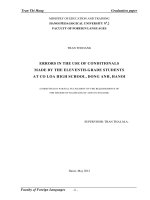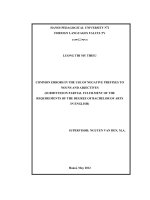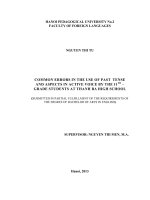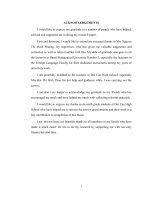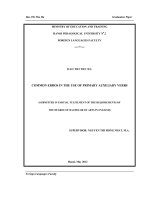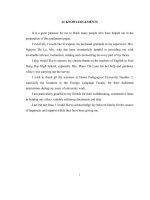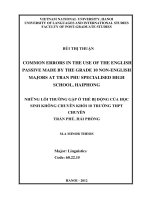Commom errors in the use of comparative sentences of adjtives made by nam tien hai high school students
Bạn đang xem bản rút gọn của tài liệu. Xem và tải ngay bản đầy đủ của tài liệu tại đây (399.51 KB, 56 trang )
HANOI PEDAGOGICAL UNIVERSITY No.2
FOREIGN LANGUAGE FACULTY
PHAM THI NGUYET
COMMON ERRORS
IN THE USE OF COMPARATIVE SENTENCES
OF ADJECTIVES MADE BY NAM TIEN HAI
HIGH SCHOOL STUDENTS
(Graduation paper submitted in partial fulfillment of the Degree of
Bachelor of Arts in English)
Hanoi, May 2013
i
HANOI PEDAGOGICAL UNIVERSITY No.2
FOREIGN LANGUAGE FACULTY
PHAM THI NGUYET
COMMON ERRORS
IN THE USE OF COMPARATIVE SENTENCES
OF ADJECTIVES MADE BY NAM TIEN HAI
HIGH SCHOOL STUDENTS
(Graduation paper submitted in partial fulfillment of the Degree of
Bachelor of Arts in English)
SUPERVISOR: PHI THI THO, B.A
Hanoi, May 2013
ii
ACKNOWLEDGEMENT
I own Mrs. Phi Thi Tho, B.A, my supervisor, great gratitude for her
inestimable support and careful guidance throughout the process of writing this
research.
Also, I would like to express my great thanks to my all beloved lecturers
who always motivated and suggested me to finish my research soon.
Furthermore, I want to express my special thanks to all the students in
grade 11 from Nam Tien Hai high school because of their support in the survey.
Last but not least, I would like to thank my beloved family and all my
friends who never stop encouraging me to finish my research.
iii
ABSTRACT
Comparison of adjectives are a basic and interesting category of English
grammar. There are many types of comparison of adjectives, and each type has
its own characteristics as well as uses. So far the uses of the adjectives referred
in some books have not been dealt with in full and it is sometimes difficult for
students to understand and use correctly. Therefore, learners sometimes confuse
types of comparison of adjectives and usually make errors in the uses of
comparison with adjectives.
Therefore, this study focuses on common errors in the uses of comparison
of adjectives. The most important objectives of the research work is to show
how to make a correct comparison of adjectives and suggest some solutions to
the common errors in the uses of comparison of adjectives.
Based on material analysis and error analysis with the assistance of the
test survey, common errors in the uses of comparison of adjectives have been
analyzed clearly. Consequently, the noticeable rules as well as solutions to these
problems are convenient to understand in using comparison of adjectives in
English.
iv
STATEMENT OF AUTHORSHIP
Title: Common errors in the use of comparative sentences of adjectives made by Nam
Tien Hai high school students
(Submitted in partial fulfillment of the requirements for degree of bachelor of Arts in English)
I certify that no part of the above report has been copied from any other
person’s work without acknowledgements and that the report is originally
written by me under instructions of my supervisor.
Date submitted: May 2013
Student
Supervisor
PHAM THI NGUYET
PHI THI THO, B.A
v
TABLE OF CONTENTS
ACKNOWLEDGEMENT ................................................................................ i
ABSTRACT ..................................................................................................... iv
STATEMENT OF AUTHORSHIP ................................................................. v
TABLE OF CONTENTS ................................................................................ vi
PART ONE
INTRODUCTION
I. RATIONALE ................................................................................................ 1
II. RESEARCH PRESUPPOSITION ............................................................. 2
III. RESEARCH OBJECTIVES ..................................................................... 2
IV. RESEARCH SCOPE ................................................................................. 2
V. RESEARCH TASKS ................................................................................... 2
VI. RESEARCH METHODS .......................................................................... 3
VII. RESEARCH SIGNIFICANCE ................................................................ 3
VIII. RESEARCH DESIGN ............................................................................ 3
PART TWO
DEVELOPMENT
CHAPTER ONE
THEORETICAL BACKGROUND
I.1. LITERATURE REVIEW IN BRIEF ....................................................... 5
I.2. COMPARISON OF ADJECTIVES.......................................................... 6
I.2.1. Definitions of adjectives............................................................................ 6
I.2.2. Descriptive adjectives ............................................................................... 7
I.2.2.1. The main functions of descriptive adjectives .......................................... 7
I.2.2.2. Classification of adjectives used in comparison...................................... 9
I.2.2.2.1. Short adjectives ................................................................................... 9
I.2.2.2.2. Long adjectives (disyllabic adjectives) .............................................. 11
vi
I.2.2.2.3. Irregular adjectives ............................................................................ 12
I.2.3. Comparative forms of adjectives and their functions ............................... 13
I.2.3.1. Single comparison ................................................................................ 13
I.2.3.2. Double Comparison ............................................................................. 18
I.2.3.3. Multiple Numbers Comparison ............................................................ 18
I.2.4. Substitutions, omissions and additions in comparative patterns ............... 19
I.2.4.1. Substitutions in comparative patterns ................................................... 19
I.2.4.2. Omissions in comparative patterns ....................................................... 20
I.2.4.3. Additions in comparative patterns ........................................................ 20
I.2.5. Intensifier ................................................................................................ 21
CHAPTER TWO: COMMON ERRORS IN THE USE OF
COMPARATIVE SENTENCES
II.1. SURVEY ................................................................................................. 22
II.1.1. Purpose of the survey ............................................................................. 22
II.1.2. Population of the survey ........................................................................ 22
II.1.3. Type of the survey ................................................................................. 22
II.1.4. Construction of the test .......................................................................... 22
II.1.5. Preparation of the survey ....................................................................... 23
II.1.5.1. Test items............................................................................................ 23
II.1.5.2. Arrangement of the test items ............................................................. 23
II.1.6. Administration of the try-out ................................................................. 24
II.1.6.1. Preparation of the try-out .................................................................... 24
II.1.6.2. Try-out ................................................................................................ 24
II.1.7. Methods of data analysis ........................................................................ 25
II.1.8. Results of the survey .............................................................................. 25
II.2. COMMON ERRORS AND CAUSES ................................................... 27
II.2.1. Errors when using multiple numbers comparison.................................. 27
II.2.2. Errors when using absolute adjectives.................................................... 28
II.2.3. Errors when using double comparison ................................................... 28
vii
II.2.4. Errors when using intensifier in comparison .......................................... 29
II.2.5. Confusion between short adjectives and long adjectives ........................ 29
II.2.6. Wrong form of irregular adjectives ........................................................ 30
II.2.7. Wrong forms of superlative structure ..................................................... 30
II.2.8. Wrong forms of comparative structure ................................................... 31
II.2.9. Errors when adding er and est ................................................................ 31
II.2.10. Wrong forms of comparion at the lower degree ................................... 32
II.2.11. Wrong forms of comparison at the same degree................................... 32
II.3. SUGGESTED SOLUTIONS AND SUGGESTED EXERCISES ........ 33
II.3.1. Suggested solutions................................................................................ 33
II.3.1.1. Thorough lecture can solve the difficulty. ........................................... 33
II.3.1.2. Negative influences of mother tongue should be limited. .................... 33
II.3.1.3. Paying attention to difficult structures is necessary. ............................ 34
II.3.1.4. Students also should study more about adjectives. .............................. 34
II.3.2. Suggested exercises ............................................................................... 34
PART THREE
CONCLUSION
REFERENCES ............................................................................................... 38
APPENDICES ................................................................................................ 40
viii
PART ONE:
INTRODUCTION
I. RATIONALE
In Vietnam as well as in other countries, there is a greater and greater
need to learn English. No one can deny the importance of English in Vietnam at
present. Therefore, English is being taught at every educational level.
However, using English grammar structures is never easy to Vietnamese
learners because of the complex structures and the differences between the two
languages.
There is a fact that comparative structures are an important part of English
grammar that high school students often see in exercises. Using comparison of
adjectives correctly is rather complex because there are many types of
comparison of adjectives, and each type has many rules of adjective forms and
structures. It is assumed that there are many errors which maybe made. Students
sometimes can not distinguish comparative types or some often give a wrong
form of comparative structures due to the influence of mother tongue. For
example:
He is more happyer than me.
She ate as twice as much as me.
Mary is so beautiful as Anna.
As the reasons above, this study was conducted to give basic theory about
comparative structures and show the errors students often make when using this
type of sentences. Then base on the errors they made, the causes of the problems
were found out and some solutions was proposed to limit the errors.
1
II. RESEARCH PRESUPPOSITION
1. What kinds of errors in using comparison of adjectives are made by the high
school students?
2. What are the causes of the errors in using comparison of adjectives made by
high school students?
3. What are the effective ways to minimize the errors made by the high school
students?
III. RESEARCH OBJECTIVES
The objectives of the study is to:
1. Find out the kinds of errors in the use of comparison of adjectives made by
the senior students.
2. Find out the causes of the errors in the use of comparison of adjectives made
by the senior students.
3. Offer some suggestions to minimize errors in using comparison of adjectives.
IV. RESEARCH SCOPE
The general research area of this study is grammar. The phenomenon is
the errors in using comparison of adjectives made by one hundred students at
Nam Tien Hai high school. One hundred students from class 12a1 and 11a4 are
the subjects of the survey.
V. RESEARCH TASKS
The research work involves a number of tasks:
1. Studying the theory of comparison of adjectives
2. Conducting a survey to find out error types that high school students often
2
make
3. Suggesting some solutions to minimize the students’ errors
VI. RESEARCH METHODS
With the aim of finding the common errors as well as their possible
solutions in using comparison of adjectives in English, the following methods
have been applied:
1. Selecting necessary data and synthesizing theoretical materials relating to
comparison of adjectives
2. Conducting a survey in order to find out common errors when using
comparison of adjectives
3. Suggesting solutions
VII. RESEARCH SIGNIFICANCE
The research is hoped to have significances as following:
1. Helping Nam Tien Hai high school students understand about comparison of
adjectives in English
2. Helping Nam Tien Hai high school students minimize their errors in using
comparative of adjectives
3. Becoming a useful reference in the issue of comparison and adjectives for
both teachers and students to make sure that they can deeply understand things
relating to comparison of adjectives
VIII. RESEARCH DESIGN
The research has three main parts: Introduction, Development, and
Conclusion.
3
The part Development consists of two chapters.
Chapter one named Theoretical Background presents literature review in
brief and the definition, function, comparative forms of adjectives. Also, the
differences among types of comparison of adjectives are mentioned.
Chapter two is Common errors in the use of comparison of adjectives. It
consists of three sections. Section one is devoted to survey. The second
mentions to error types and causes. The last one provides solutions to the
problems and suggests exercises on comparison of adjectives.
4
PART TWO
DEVELOPMENT
CHAPTER ONE
THEORETICAL BACKGROUND
I.1. LITERATURE REVIEW IN BRIEF
Comparison of adjectives has been studied by many grammarians like
Alexander (1988), Harrison (1998), Jocelyn (1997), Eastwood (1992) and so on.
In general, they focus their attention on classification of comparison of
adjectives and their uses. Most of the knowledge they present are really useful
for high school students.
Eastwood (1992) focused on the differences between comparison of
superiority and superlative comparison.
Jocelyn (1997) studied comparative forms of adjectives. He also
mentioned some special notes when using comparison of adjectives such as
substitutions, omissions and additions in comparative patterns.
Vince (1851) introduced the uses of some types of comparative forms of
adjectives.
Brown (1851) showed both regular and irregular comparison.
To sum up, many researchers have studied about comparison of
adjectives. However, not many of them have deeply studied the special cases of
comparatives as well as the differences among types of comparison of
adjectives. Besides, the errors students make when using comparison of
adjectives have not studied specifically.
Therefore, it is essential to have a comprehensive study of the common
errors in the use of comparison of adjectives.
5
I.2. COMPARISON OF ADJECTIVES
I.2.1. Definitions of adjectives
According to Alexander (1988), an adjective describes the person or thing
which a noun refers to. We use adjectives to say what a person or thing is like or
seems like. For example, adjectives can give us information about:
Quality: a beautiful dress, a nice day
Size: a big car, a small coin
Age: a new handbag, a young man
Temperature: a cool evening, a hot day
Shape: a round table, a square box
Color: blue eyes, grey hair
Origin: a Japanese camera, a Swiss watch
To identify whether a word is an adjective or not, learners can sometimes
base on suffixes of the words. Here are the main suffixes:
(1): -ful: wonderful, beautiful, forgetful
(2): -less: thoughtless, worthless, lawless
(3): -able: acceptable, likeable, charitable
(4): -ible: edible, terrible, irresistible
(5): -en: golden, woolen, wooden
(6): -ous: glorious, victorious, mischievous
(7): -al: musical, national, natural
(8): -ive: imaginative, destructive, descriptive
(9): -ic: heroic, scientific, poetic
(10): -ish: childish, selfish, English
(11): -ary: customary, secondary, imaginary
6
(12): -some: handsome, quarrelsome, lonesome
(13): -y: silky, shady, smoky
(14): -ly: friendly, manly, lonely
I.2.2. Descriptive adjectives
Adjectives used in comparison are descriptive adjectives. Therefore, in
this research, only descriptive adjectives are studied.
I.2.2.1. The main functions of descriptive adjectives
According to Quirk, et.al. (1972), adjectives have main functions as
following:
• Used as attributives and predicative
The major syntactic functions of adjectives are attributive and predicative.
These are termed the major syntactic functions, since a word that cannot
function either attributively or predicatively is not recognized as an adjective.
Adjectives are attributive when they modify nouns. Attributive adjectives
appear between the determiner and the head of the noun phrase:
The beautiful painting
A mere child
His main argument
Predicative adjectives can be:
(1): subject complement: there is co-reference between subject and subject
complement, the two being in an intensive relationship:
Your daughter is pretty.
He is handsome.
(2): object complement: there is co-reference between direct objects and object
complement, the two being in an intensive relationship. For example:
7
I consider him foolish.
He made his wife happy.
• Used as postposition
Adjectives can sometimes be postpositive; they can sometimes follow the
noun or pronoun they modify. A postposition adjective (together with any
complementation it may have) can usually be regarded as a reduced relative
clause.
Complex indefinite pronouns ending in -body, -one, -thing, -where can be
modified only postpositively:
Anyone (who is) intelligent can do it.
I want to try on something (that is) larger.
Of course, adjectives that can occur only attributively are excluded:
Something (which is) main
Somebody (who is) mere
• Used as heads of a noun phrase
Adjectives can function as heads of noun phrases and can be subjects of
the sentence, complement, object, and complement of a preposition. Adjectives
as noun-phrase heads do not inflect for number or for the genitive case and they
must take a definite determiner. These types of adjectives function as nounphrase heads.
All adjectives qualifying personal nouns can be noun-phrase heads:
The poor are causing the nation’s leaders great concern
There is a lack of communication between the young and the old.
• Used as supplementive adjective clauses
Adjectives can function as the sole realization of a verbless clause or as
the head of an adjective phrase realizing the clause. One such type of verbless is
8
the supplementive adjective clause.
Nervous, the man opened the letter.
The man, nervous, opened the letter.
The man opened the letter, nervous.
As the above examples demonstrate, the supplementive adjective clause is
mobile, though it usually precedes or follows the subject of the super-ordinate
clause. When it follows the subject, as in, it is in some respects like a nonrestrictive relative clause.
The men, who was nervous, opened the letter.
But the adjective clause suggests that the man’s nervousness was shown,
whereas the relative clause does not convey that implication. The difference is
because the adjective clause is related to the predication as well as to the subject.
Furthermore, unlike the relative clause, the adjective clause is mobile and its
implied subject is the subject of the sentence. Thus, while we have “The man
restrained the woman, who was aggressive”, we do not have as its equivalent
“The man restrained the woman, aggressive.”
I.2.2.2. Classification of adjectives used in comparison
There are some ways to classify adjectives. They can be classified based
on their functions, their formations, their uses, etc. In this research, adjectives
are divided into 3 types: short adjectives, long adjectives and irregular
adjectives, so that the study on comparison of adjectives can be done
conveniently.
I.2.2.2.1. Short adjectives
Many short adjectives form comparatives and superlative with -er and
-est.
9
Positive degree
Comparative degree
Superlative degree
cheap
cheaper
cheapest
tall
taller
taller
small
smaller
smallest
long
longer
longest
Monosyllabic adjectives can normally form their comparison by
inflection. Many disyllabic adjectives can also do so, though like most
monosyllabic adjectives they have the alternative of the periphrastic forms:
My jokes are funnier/ funniest// more funny/ most funny.
Common disyllabic adjectives that can take inflected forms are those
ending in an unstressed vowel, syllabic /l/, or / (r)/ (Randolph Quirk and
Sidney Greenbaum, 1973):
(1) -y: funny, noisy, wealthy, friendly
(2) -ow: hollow, narrow, shallow
(3) -le: gentle, feeble, noble
(4) -er, -ure: clever, mature, abscure
*Note: spelling of comparative and superlative forms (Alexander, 1988)
1. Most one-syllable adjectives form their comparatives and superlatives are
added to their basic forms. Some examples are hot, cold, strong, etc.
2. Many one-syllable adjectives end with a single consonant after a single
vowel-letter. This consonant doubles in the comparatives and superlative, as in
the case of big. Other example like big are fat→ fatter → fattest; sad → sadder
→ saddest; thin → thinner → thinnest, etc.
10
3. Many one-syllable adjectives ending in -e, like nice, are added -r and -st to
the basic form. Other examples like nice are fine, large, late, safe, etc.
4. Some adjectives, like tidy, end in y with a consonant letter before it. These
adjectives are usually two-syllable. In the comparative and superlative y is
replaced by i. other examples like tidy are busy, dirty, dry, easy, etc.
I.2.2.2.2. Long adjectives (disyllabic adjectives)
Most long adjectives combine with the quantifiers more/less to form their
comparatives and most/ least to form their superlatives. Less can be used with
one-syllable adjectives but more/ most and least are not normally used in this
way. More is occasionally used with one-syllable adjectives(e.g. it’s more true
to say that British English is influenced by American, rather than the other way
round.) more/ less can never be used in front of a comparative (e.g. happier); nor
can most/ least be used in front of a superlative (e.g. happiest).
Adjective
1. pleasant
2. careful
3. expensive
Comparative
Superlative
more pleasant
the most pleasant
less pleasant
the least pleasant
more careful
the most careful
less careful
the least careful
more expensive
the most expensive
less expensive
the least expensive
* Notes on the comparison of longer adjectives (Alexander, 1988):
(1): Some two-syllable adjectives can form their comparatives and superlatives
either with -er and -est or with more/ less and most/ least. Other examples like
pleasant are common, handsome, stupid, tired, etc. The opposites of such words,
11
when formed with the prefix un, can also form their comparatives and
superlatives in two ways: e.g. uncommon, unhappy, unpleasant, unhappier or
more unhappy, unhappiest or most unhappy. Where there is uncertainly, it is
safest to use more and most with two-syllable adjectives.
(2): The comparatives and superlatives of other two-syllable adjectives must
always be with more/ less and most/ least. These include all adjectives ending in
-full or -less (e.g. careful, careless, useful, useless)
Other examples of adjectives which form comparisons in this way are
(un)certain, (in)correct, (in)famous, foolish, (in)frequent, modern, (ad)normal.
Adjectives with more than two syllable compare with more/most and less/ least
such as beautiful, comfortable, dangerous, expensive, important, etc.
This applies to most compound adjectives as well, such as quick-witted,
waterproof. However, note compounds with good, well, and bad: good-looking
→ better-looking (or more good-looking); well-built → better-built (but more
well-built is sometimes heard); bad-tempered → worse-tempered (or more badtempered).
I.2.2.2.3. Irregular adjectives
A number of irregular comparative adjective forms in English cannot be
explained with reference to the -er inflection or the periphrastic form more:
Adjective
Comparative
Superlative
good
better
the best
bad
worse
the worst
far
farther
the farthest
further
the furthest
older
the oldest
old
12
much
elder
the eldest
more
the most
less
the least
many
little
I.2.3. Comparative forms of adjectives and their functions
Each comparative form of adjectives has its own function. However, in
general, comparatives are normally used to compare two things, people or ideas
I.2.3.1. Single comparison
■ The same degree
We use as…as with an adjective in between to say that something or
someone is like something or someone else, or that one situation is like another.
For example:
Was the film as funny as his last one?
It is said in the book Advanced grammar in use (1999) that if you put a
countable noun between the adjective and the second as, you should use a/ an in
front of the noun (if the noun is singular). For instance:
She was as patient a teacher as anyone could have had.
Degrees of similarity can be expressed by means of almost, exactly, just,
nearly + as + adjective. For example:
Jeffrey is nearly as tall as his father now.
■ The lower degree
Negative forms of sentences like this can use either not as or not so. In
formal speech and writing, it is more common to use less than. For example:
The gap between the sides is not as wide as it was.
13
The gap between the sides is less wide than it was.
The bees are plentiful, but not so common as last summer.
The bees are plentiful, but less common than last summer.
Not such a/ an (+adjective)+ noun is also possible. For instance:
He’s not such a hard worker as his brother.
■ Comparatives
Comparatives can also be used to compare one thing and a group of many
things considered together, or one thing and everything else in the group.
For example:
Mary is cleverer than the three sisters.
Mary is cleverer than everyone else in her class. (= Mary is the
cleverest student in class.)
In all the above examples, there is a phrase beginning with than… which
states the thing(s) which the subject of the sentence is compared to. In the
following examples, the than… phrase is left out and it is clear from the context,
that the things or people concerned are compared with themselves over a period
of time. In the other words, comparatives are used to indicate changes over a
period of time. For example:
With practice, we find the task easier.
As he grew older, he became wiser.
We will have to be more careful.
A few adjectives are spelt like comparatives and they convey the meaning
of comparison, but they do not serve the normal functions of comparatives.
They function more as adjectives of the positive degree and cannot be followed
by a phrase beginning with than. Such adjectives include upper, elder, utter,
inner, outer, interior, exterior, ulterior, major, minor.
14
For example:
He belongs to the upper class. (CORRECT)
His social class is upper than mine. (WRONG)
He is my elder brother. (CORRECT)
He is elder than I. (WRONG)
John is an utter fool. (CORRECT)
As a fool, John is more utter than others. (WRONG)
This is the inner wall. (CORRECT)
This wall is inner than that wall. (WRONG)
The following adjectives are not followed by than but by to: interior,
superior, anterior, prior, posterior, senior, junior:
For example:
John is interior than Tom in dancing skills. (WRONG)
John is inferior to Tom in dancing skills. (CORRECT)
There are many managers senior than George. (WRONG)
There are many managers senior to George. (CORRECT)
* Notes: The use of than in the comparative
A comparative can stand on its own if the reference is clear.
The grey coat is longer.
This implies that the hearer understands that the grey coat is being
compared with another coat or something similar. If two things of exactly the
same kind are being compared, we can use the before a comparative in formal
style.
Which is (the) longer? (of the two coats)
The grey coat is (the) longer. (of the two coats)
15
However, if we need to mention each item, then we must use than after
the comparative: when than is followed by a noun or pronoun, it functions as if
it were a preposition; when it is followed by a clause, it functions as if it were a
conjunction, but note the ambiguity of “I know him better than you.” This could
mean:
I know him better than you know him. (than is a conjunction)
I know him better than (I know) you. (than could be a preposition)
■ Superlatives
Superlatives are normally used when more than two things, people or
ideas are compared. A superlative is used to refer to the thing, person or idea
that is the most outstanding in a certain quality.
For example:
Of all the projects that have been completed, mine is the best.
I’m the youngest in the family.
Tom is the richest person in this district.
It is important to remember that most is sometimes used to mean very. So
an adjective that has most in front of it is not necessarily a superlative. It is a
superlative only if it involves comparison of things, people or ideas.
What you say is most interesting. (most = very)
John is the most interesting person in this district. (a superlative )
The definite article the is used before a superlative in a phrase or
sentence. Sometimes superlatives are qualified by ordinal numbers. For
example:
John is the second richest person in this country.
Informally, we sometimes use the superlative instead of a comparative
when we are comparing two people or things. For example:
16
Who’s the most reliable, Frank or Alan?
Similarly, the is sometimes dropped, especially after which.
Which is best? The red one or the green one?
And when the superlative is in front of a to-infinitive.
I think it’s safest to overtake now.
* Notes: The use of a qualifying phrase or a relative
A qualifying phrase is not necessary after a superlative if the reference is
clear, for example, John is the tallest.
This implies that the hearer understands that John is being compared with
two or more people in the same group. If the comparison is not clear, then we
must use a qualifying phrase after the superlative. Phrases of this kind usually
begin with in or (less frequently) of. For example:
John is easily the tallest boy in our class.
Yesterday is the hottest day of the year.
Other fixed prepositional phrases are possible:
For example: It’s the oldest trick on earth.
Alternatively, we can use a relative clause after a superlative. This is often
accompanied by a present perfect with …ever heard, met, read, seen, etc. For
example:
“War and Peace” is the longest book I have ever heard.
Penfold is the most conceited man I have ever met.
To make a superlative negative, put the least before the adjective.
For example:
The least funny
The least polite
17
